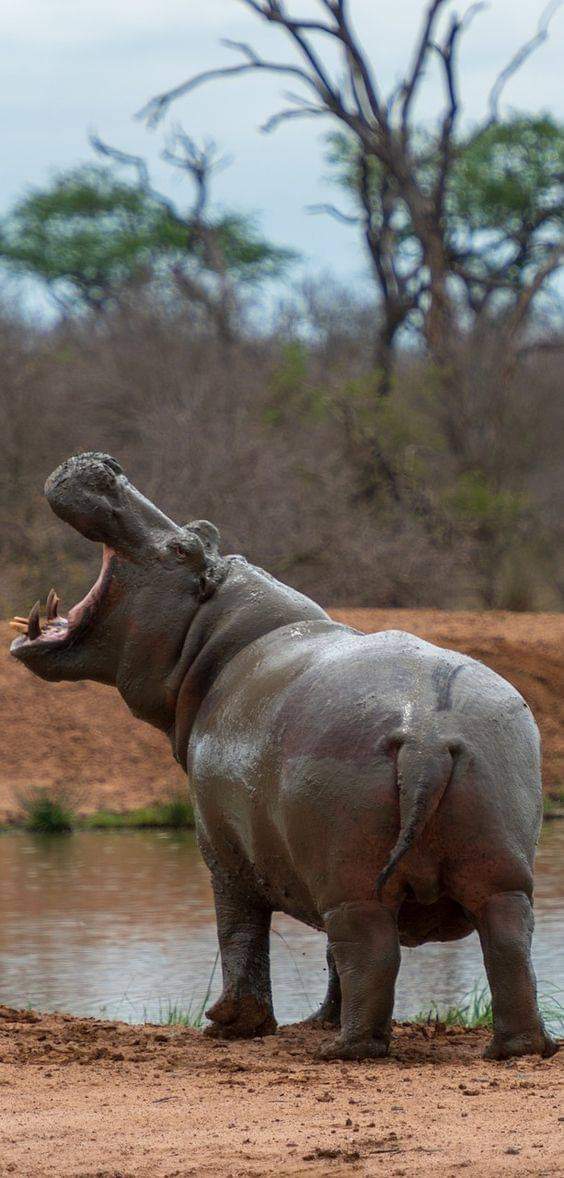
African Hippos are territorial, but only in water and not on land. The common African hippo spends up to 16 hours every day in water. When the hippo is under water, as they cannot float and walk on the bottom of the lake or river, they have to rise every 5/6 minutes to take a breath of air and then sink back down to eat some more water vegetation.
We see a mother hippo with a young calf, and one older and they are often seen with another adult, or two mature females. This is can be the mother’s older calves as they can still be near their mother for years, or the rest of their lives. The males leave and breeding bulls change, but the girls stay the same and are tolerant of unrelated young sub-adults — not so much the bulls!
African Hippo bulls are territorial in water, but not out in pastures (grazing) all have home ranges at night, and these can vary between 250 – 500 metres of river land or Lakeshore. At night, African hippos leave the water and follow well-worn paths to grazing areas — at these times they usually separate and graze alone. A question that has sprung up, is that some of you wonder how do the bulls scent mark when in water?
A bull defends about 50-100 metres of water and he defends only breeding rights, not like most animals that defend territory for feeding and breeding rights. Bulls defend, quite aggressively, this area of water and they spread their scent by flinging dung all over the water, quite often, by swishing his tail like a fast vehicle’s windscreen wiper — called ‘dung showering’..
On land they have piles of middens (dung heaps) on pathways leading into and out of the water. Some of these can be so high that they reach the bull’s anus!
The common hippo (also called the river hippo) is the one we see the most — the ‘Agro big-boy’.
African Hippos are herbivores and spends most of their day in water — and are therefore classified as ‘semi-aquatic’.
The common African hippo was found in more areas, but now inhabit East, Central and Southern Africa — their numbers are growing less and are now classified as ‘vulnerable’.
Welcome to Crying buffalo’s hippopotamus-day!
We will start the day by answering 3 most popular questions:
- The hippo is only native to Africa.
- We find two species of hippo — the larger and more aggressive hippo, that prefers to live in pods (hippo group) of about 10-15 — the common hippo. And then the smaller (about half the weight of the common hippo), far less aggressive — a shy hippo that tends to be alone (unless with a calf), but can be seen in pairs — the pygmy hippo.
- Yes, the African hippo is one of the world’s heaviest living land animals.
- The first is the elephant, then the white rhino (not the black rhino) and close behind, or sometimes heavier is the common hippo.
Facts about the Pygmy African Hippo
Pygmy Hippopotamus is so named because of its short size. This shy and secretive AFrican hippo is found in the swampy areas of a few West African countries, and their current population is less than 2, 000 — 3, 000 individuals, but the true figure is unknown as they are difficult to count being so elusive.
Habitat loss has been the biggest problem due to farming, settlements and logging. The Endangered Species Acts covers them not to be traded or their trophies, but the laws are not enforced.
*This rare hippo is currently endangered.
The rare and endangered pygmy hippo spends the day resting in wet or moist places (that is why the rainforest is perfect for them, and no wonder they are smaller because the common hippo would find it extremely difficult to move around in those dense habitats). It rests not only there, but can be found in drier areas, but because they are so shy, they are never far from the safety of the rainforest’s cover.

African Hippos leave the water at night to feed and they do not fight when out of the water. These areas are accessible to all. Like the pygmy hippo, the common African hippo is also mostly a nocturnal feeder.
Hippos sink — they do not float and propel themselves through water — like jumping/leaping forward so that it looks like they are flying. They are remarkably fast and agile underwater — even the calves sink and they suckle underwater and can (all hippos) close their ears to prevent water getting into the inner ear. The calves rise about every five minutes, take a breath of air and then sink down to suckle a bit more.
Sometimes, you may see a hippo feeding off a carcass and think this is an omnivore as it eats meat as well as vegetation. The hippo is a herbivore, so eats vegetation — mainly grass. When it does that it is likely sick and lacking an important nutrient that only meat provides in its natural form — so it eats the flesh to feel better (it cannot dash to the pharmacy to pick up some vital pills). Another reason, is it could be highly stressed and therefore, showing abnormal behaviour.
Bulls can attack and kill calves, but a hippo is a good mother and often plays with her calf underwater and often successfully defends her calf from an attacking bull. The reason why they often injure and chase the bull away, is because of the way they attack. Bulls fight head-on, but the cows attack from the side.
African hippo bulls attract the cows by using vocalisations (sounds) and flinging their dung (that will not work on humans, but it does for hippos!). Hippos mate in the water, and the cow is only partly underwater.
In the dry season, African hippos are more aggressive because there is less water, thus bringing more pods closer together. This also means that dominant bulls have to share and compete in the same waters. During these harsh times, their river source might dry up, or shrink drastically to muddy pools. Hippos will often travel over lands to find a fresher water source — they can travel 40-60 km (24-30 miles) in one night.
During the wet season, usually the height of the wet season, and after an 8-month gestation, hippo cows give birth to one calf. All African hippos tend to give birth in water and the common hippo will do this away from the pod. After about 3 days, she and the calf have bonded and the calf is a little tougher, she returns to the pod.
We have heard this and some may think that all hippos actually sweat blood. No, not actual blood. This is an oily secretion (a type of sweat) that has a pink/red-like colour and this covers their body and protects their skin from long hours in the water, and also acts like a sunscreen. This is found in both species of hippo.
We might see a broad path leading from the water and think a lot of people come here… That is more than likely a hippo path. All hippos are nocturnal and just before it gets dark, they leave the water and follow their branches of ‘hippo-paths’. These well-trampled paths can average 3 – 5 km (1.9 – 3 miles).
Hippos milk is bright pink. The reason is that the hippo secretes two kinds of unique acids called “Hipposudoric acid” and “Norhipposudoric acid”. The former is reddish in color and often known as “blood sweat”, although it is neither blood nor sweat.
During the period that the hippo’s secretions are at their orange-red peak, it’s possible that some could mix with the milk, giving it a pinkish hue.
This important to note; African hippo is the number one killer of human being in the world and its just kill people in Africa because they are only found in Africa. Lifespan of an African hippo it 40yrs in the wild and 50yrs in captivity
I think we confused you with the hippo’s ‘blood-sweat’, so we will clear a few things up. Although this can be called a type of sweat — to make it easier to describe — it is actually not actual sweat as hippos have no sweat glands. Animals have sweat glands to produce sweat which cools the animal when air flows over its surface. Hippos do not need that as the water cools them. They still have glands, though… Not sweat glands, but different glands that produce that ‘blood-sweat’ It is there to protect their skin from the sun, prevent dehydration when out of the water and also protects the skin in long hours in the water.
The hippo’s front teeth are no longer needed to graze grass (they use their tough and thick lips to nip grass), so they have become weapons — used for display, fighting and defense.
Baby hippos are born underwater. Their nose is automatically sealed, as well as their ears, The birthing process is done away from the herd and once born, the Mother goes into seclusion with her calf for a few days before she introduces it to the herd.
- After giving birth in water, she is taking her newborn calf away from the other hippos. Sometimes, hippos might kill a calf, but this is often a young mother that brought the calf back too soon b- like 2 or three days after it was born.
African Hippos look like they are slow. Nope.
Living on earth, the fastest human in 100 m sprint is 28 kilometres per hour, which is 17 miles per hour. Therefore, most animals will outrun a human because a human is unable to keep that top speed, usually for longer than 100 metres.
The average human cannot keep that pace for long, either.
- A hippo runs at 30-40km/h (19-25mph). Faster than the average human.

